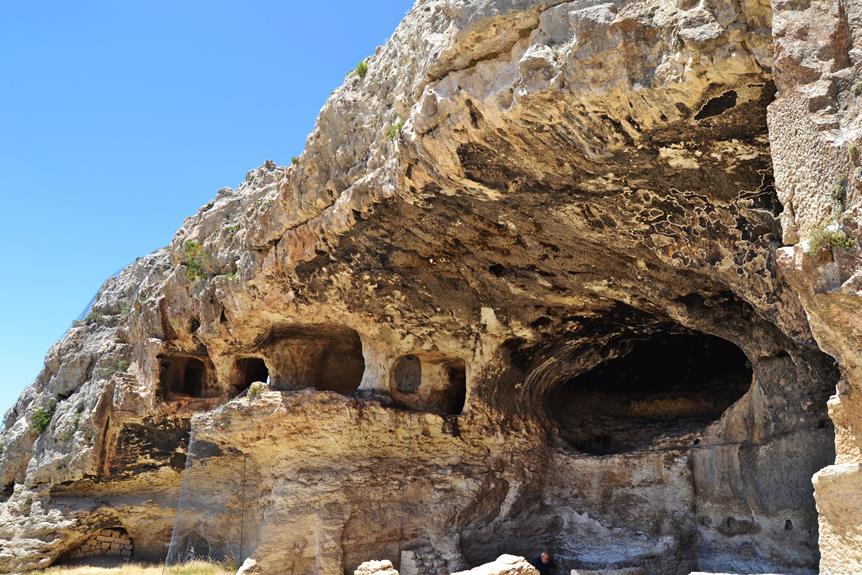Ladies and gentlemen, prepare to have your minds blown! Let me tell you why Algarve's caves and grottos are geological wonders that will leave you in awe.
Picture this: over millions of years, these caves have been sculpted by Mother Nature herself, as if she were a master artist. The cliffs erode, the waves crash, and voila! Intricate rock formations and spacious cavities are born.
One such marvel is the Benagil Cave, a majestic dome filled with stalactites and stalagmites created by the slow dripping of mineral-rich water. It's like stepping into a secret underworld of natural beauty.
So, if you're up for an adventure, grab your spelunking gear and get ready to explore these mind-boggling geological treasures in Algarve!
Key Takeaways
- Algarve's caves and grottos are formed through erosion and wave action over millions of years, showcasing intricate rock formations and stalactites/stalagmites.
- The interplay of light and shadow, along with the mineral-rich water, enhances the beauty of the formations, making them geological wonders.
- The combination of limestone, sandstone, and volcanic rock in the region creates a perfect canvas for nature's artistry, including towering cliffs, sandstone cliffs, and volcanic chimneys adorned with intricate mineral deposits and formations.
- Algarve's caves and grottos serve as geological time capsules, preserving artifacts from ancient eras and offering insights into Earth's past and the evolutionary history of the region.
Formation of Unique Cave Structures
As a geologist, I'm fascinated by the intricate and unique formations that can be found within the caves and grottos of the Algarve region. One of the most remarkable examples is the Benagil Cave.
This natural wonder boasts breathtaking rock formations that have been formed over millions of years. The constant erosion by the sea has sculpted the cave's walls into a mesmerizing display of geological artistry. Stalactites and stalagmites adorn the cave, creating a whimsical and otherworldly atmosphere.
The interplay of light and shadow enhances the beauty of these formations, making it a sight to behold. It's almost as if Mother Nature herself has humorously crafted a masterpiece within this hidden gem.
The Algarve's caves and grottos truly showcase the remarkable power and creativity of our planet's geological processes.
Geological Significance of Algarve's Caves
From my perspective as a geologist, the Algarve's caves and grottos hold a double prepositional significance in terms of their geological formations and processes.
These formations, such as the Algar de Benagil and the hidden sea caves within the cliffs of Cabo Espichel, provide invaluable insights into the erosive power of the sea and the transformative effects of time.
These caves showcase the dynamic interplay between the ocean and the cliffs, resulting in the creation of unique geological features.
The intricate rock formations, stalactites, stalagmites, and mineral deposits found within these caves offer a window into the Earth's past, revealing the complex processes that have shaped our planet over thousands of years.
Furthermore, the caves serve as geological time capsules, preserving artifacts from ancient eras, like the Paleolithic era artifacts found in Gruta do Capitão.
Erosion and the Creation of Grottos
As a geologist, I've observed that the erosion process plays a crucial role in the formation of grottos, such as Algar de Benagil and Algar do Carvão, in the Algarve region. Over thousands of years, the relentless force of the sea has carved and shaped these magnificent geological wonders.
Allow me to explain the fascinating process of erosion and its impact on the creation of grottos:
- Erosion by the sea gradually wears away the coastal rocks, shaping them into intricate caves and grottos.
- The constant pounding of waves against the cliffs weakens the rock, causing it to crumble and form openings.
- These openings then serve as entry points for the sea, which further erodes the rock, enlarging the caves and grottos.
Through this relentless dance between the sea and the rocks, the Algarve region is blessed with breathtaking caves and grottos that captivate the imagination.
The Role of Algarve's Coastal Geology
I've observed how the coastal geology of the Algarve region plays a crucial role in shaping the magnificent caves and grottos. The combination of various geological formations, such as limestone, sandstone, and volcanic rock, creates the perfect canvas for Mother Nature's artistic touch. Picture this: on one side, towering cliffs made up of layers of limestone and sandstone, eroded over time to create a dramatic landscape. On the other side, volcanic chimneys adorned with intricate mineral deposits and formations. In between, hidden sea caves with dome-shaped openings that allow sunlight to filter in, revealing sparkling waters and intricate rock formations. To give you a clearer image, take a look at the table below:
| Coastal Features | Characteristics |
|---|---|
| Limestone Cliffs | Towering cliffs with layers of limestone eroded by the sea. |
| Sandstone Cliffs | Dramatic cliffs formed by the erosion of sandstone. |
| Volcanic Chimneys | Intricate mineral deposits and formations from volcanic eruptions. |
| Dome-shaped Openings | Allow sunlight to filter in, showcasing rock formations and waters. |
The coastal geology of the Algarve region provides the foundation for these geological wonders, creating a playground for nature's creativity and a visual feast for our eyes.
Exploring the Fossil Record in Caves and Grottos
Exploring the fossil record in Algarve's caves and grottos reveals a wealth of ancient artifacts and evidence of prehistoric life. These geological wonders provide a fascinating glimpse into the past, allowing us to unravel the mysteries of the region's rich history. Here are some key points to consider:
- The caves and grottos, such as Ponta da Piedade and Praia de Benagil, are nestled within majestic cliffs. These cliffs are made up of various rock formations, including limestone and sandstone, which have preserved fossils for millions of years.
- Inside these caves, you can find a diverse range of fossilized remains, including shells, bones, and even entire skeletons. These fossils offer valuable insights into the flora and fauna that once thrived in the Algarve region.
- By studying these fossils, scientists can piece together the ancient ecosystems and reconstruct the evolutionary history of the Algarve. It's like solving a prehistoric puzzle, unlocking the secrets of the past one fossil at a time.



